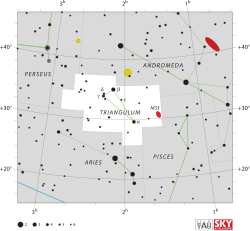Delta Trianguli, Latinized from Delta Tri, is a spectroscopic binary star system approximately 35 light-years (11 pc) away in the constellation of Triangulum. The primary star is a yellow dwarf, while the secondary star is thought to be an orange dwarf. It has an apparent magnitude of +4.87 and forms an optical (line-of-sight) triple with Gamma Trianguli and 7 Trianguli.[12]
Stellar components
editDelta Trianguli A is a main sequence star with a stellar classification of G0V and a mass similar to the Sun.[12] The spectral characteristics of the smaller companion Delta Trianguli B are not well determined since the close orbit makes observations difficult,[13] with estimates of the spectral class ranging from G9V to K4V.[3] The Delta Trianguli stars orbit their center of mass with an estimated separation of 0.106 AU;[12] it is certainly less than one AU.[3] The orbital period is 10.02 days and the eccentricity of the orbit is only 0.020. The orbit is inclined about 167° to the line of sight from Earth.[6]
A 2008 search for a tertiary companion to this system using an adaptive optics system on the VLT proved unsuccessful.[14] Examination of the system in infrared light at 70 μm shows no excess emission that would otherwise indicate the presence of a disk of orbiting dust.[3]
Naming
editIn Chinese, 天大將軍 (Tiān Dà Jiāng Jūn), meaning Heaven's Great General, refers to an asterism consisting of δ Trianguli γ Andromedae, φ Persei, 51 Andromedae, 49 Andromedae, χ Andromedae, υ Andromedae, τ Andromedae, 56 Andromedae, β Trianguli and γ Trianguli. Consequently, the Chinese name for δ Trianguli itself is 天大將軍十一 (Tiān Dà Jiāng Jūn shíyī, English: the Eleventh Star of Heaven's Great General.).[15]
See also
editReferences
edit- ^ a b c d e van Leeuwen, F. (November 2007). "Validation of the new Hipparcos reduction". Astronomy and Astrophysics. 474 (2): 653–664. arXiv:0708.1752. Bibcode:2007A&A...474..653V. doi:10.1051/0004-6361:20078357. S2CID 18759600.
- ^ a b c d Nordström, B.; et al. (May 2004), "The Geneva-Copenhagen survey of the Solar neighbourhood. Ages, metallicities, and kinematic properties of ˜14 000 F and G dwarfs", Astronomy and Astrophysics, 418: 989–1019, arXiv:astro-ph/0405198, Bibcode:2004A&A...418..989N, doi:10.1051/0004-6361:20035959, S2CID 11027621
- ^ a b c d e f Kim, Jinyoung Serena; et al. (October 2005), "Formation and Evolution of Planetary Systems: Cold Outer Disks Associated with Sun-like Stars", The Astrophysical Journal, 632 (1): 659–669, arXiv:astro-ph/0506434, Bibcode:2005ApJ...632..659K, doi:10.1086/432863, S2CID 7324203
- ^ a b Johnson, H. L.; Iriarte, B.; Mitchell, R. I.; Wisniewskj, W. Z. (1966), "UBVRIJKL photometry of the bright stars", Communications of the Lunar and Planetary Laboratory, 4 (99): 99, Bibcode:1966CoLPL...4...99J
- ^ a b White, Russel J.; et al. (June 2007), "High-Dispersion Optical Spectra of Nearby Stars Younger Than the Sun", The Astronomical Journal, 133 (6): 2524–2536, arXiv:0706.0542, Bibcode:2007AJ....133.2524W, doi:10.1086/514336, S2CID 122854
- ^ a b "Sixth Catalog of Orbits of Visual Binary Stars", U.S. Naval Observatory, archived from the original on 2009-04-12, retrieved 2008-06-22
- ^ a b Piccotti, Luca; Docobo, José Ángel; Carini, Roberta; Tamazian, Vakhtang S; Brocato, Enzo; Andrade, Manuel; Campo, Pedro P (2020-01-03). "A study of the physical properties of SB2s with both the visual and spectroscopic orbits". Monthly Notices of the Royal Astronomical Society. 492 (2). Oxford University Press (OUP): 2709–2721. Bibcode:2020MNRAS.492.2709P. doi:10.1093/mnras/stz3616. ISSN 0035-8711.
- ^ Pasinetti Fracassini, L. E.; et al. (February 2001), "Catalogue of Apparent Diameters and Absolute Radii of Stars (CADARS) - Third edition - Comments and statistics", Astronomy and Astrophysics, 367 (2): 5211–524, arXiv:astro-ph/0012289, Bibcode:2001A&A...367..521P, doi:10.1051/0004-6361:20000451, S2CID 425754
- ^ a b Clegg, R. E. S. (October 1977), "Carbon and nitrogen abundances in F- and G-type stars", Monthly Notices of the Royal Astronomical Society, 181: 1–30, Bibcode:1977MNRAS.181....1C, doi:10.1093/mnras/181.1.1
- ^ Holmberg, J.; Nordström, B.; Andersen, J. (July 2009), "The Geneva-Copenhagen survey of the solar neighbourhood. III. Improved distances, ages, and kinematics", Astronomy and Astrophysics, 501 (3): 941–947, arXiv:0811.3982, Bibcode:2009A&A...501..941H, doi:10.1051/0004-6361/200811191, S2CID 118577511
- ^ "del Tri -- Spectroscopic binary", SIMBAD, Centre de Données astronomiques de Strasbourg, retrieved 2011-09-16
- ^ a b c Kaler, James, "Delta Tri", Stars: Portraits of Stars and their Constellations, University of Illinois, retrieved 2011-09-16
- ^ Raghavan, Deepak; et al. (September 2010), "A Survey of Stellar Families: Multiplicity of Solar-type Stars", The Astrophysical Journal Supplement, 190 (1): 1–42, arXiv:1007.0414, Bibcode:2010ApJS..190....1R, doi:10.1088/0067-0049/190/1/1, S2CID 368553
- ^ Tokovinin, A.; et al. (May 2006), "Tertiary companions to close spectroscopic binaries", Astronomy and Astrophysics, 450 (2): 6811–693, arXiv:astro-ph/0601518, Bibcode:2006A&A...450..681T, doi:10.1051/0004-6361:20054427, S2CID 8899546
- ^ (in Chinese) AEEA (Activities of Exhibition and Education in Astronomy) 天文教育資訊網 2006 年 7 月 10 日 Archived 2011-07-16 at the Wayback Machine
External links
edit- "Delta Trianguli 2". SolStation. Retrieved 2008-06-22.
